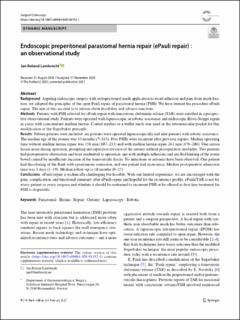| dc.contributor.author | Lambrecht, Jan Roland | |
| dc.coverage.spatial | Norway | en_US |
| dc.date.accessioned | 2021-08-18T13:35:21Z | |
| dc.date.available | 2021-08-18T13:35:21Z | |
| dc.date.issued | 2021 | |
| dc.identifier.citation | Lambrecht JR. Endoscopic preperitoneal parastomal hernia repair (ePauli repair) : an observational study. Surg Endosc. 2021 Apr;35(4):1903-1907. | en_US |
| dc.identifier.issn | 0930-2794 | |
| dc.identifier.uri | https://hdl.handle.net/11250/2770143 | |
| dc.description.abstract | Abstract
Background: Aspiring endoscopic surgery with extraperitoneal mesh application to avoid adhesion and pain from mesh fixation, we adopted the principles of the open Pauli repair of parastomal hernia (PSH). We have termed the procedure ePauli repair. The aim of this account is to inform about feasibility and adverse reactions.
Methods: Patients with PSH selected for ePauli repair with transversus abdominis release (TAR) were enrolled in a prospective observational study. Patients were operated with laparoscopic or robotic assistance and endoscopic Rives-Stoppa repair in cases with concomitant midline hernia. Coated meshes or a buffer mesh was used in the retromuscular pocket for this modification of the Sugarbaker principle.
Results: Fifteen patients were included: six patients were operated laparoscopically and nine patients with robotic assistance. The median age of the stomas was 33 months (7-313). Five PSHs were recurrent after previous repairs. Median operating time without midline hernia repair was 156 min (107-233) and with midline hernia repair 241 min (176-286). One serosa lesion arose during operation, prompting intraoperative revision of the ostomy without postoperative morbidity. Two patients had postoperative obstruction and were readmitted to operation: one with multiple adhesions and one had kinking of the stoma bowel caused by insufficient incision of the transversalis fascia. No infections or seromas have been observed. One patient had discoloring of the flank with spontaneous remission, and one patient had recurrence. Median postoperative admission time was 3 days (1-19). Median follow-up is 10 months (0-27).
Conclusions: ePauli repair is technically challenging but feasible. With our limited experience, we are encouraged with the pain, complication, and functional summary after ePauli repair and hopeful for the recurrence profile. ePauli/TAR is not for every patient or every surgeon and whether it should be restrained to recurrent PSH or be offered as first-line treatment for PSH is disputable. | en_US |
| dc.description.sponsorship | No funding. | en_US |
| dc.language.iso | eng | en_US |
| dc.rights | Navngivelse-Ikkekommersiell-DelPåSammeVilkår 4.0 Internasjonal | * |
| dc.rights.uri | http://creativecommons.org/licenses/by-nc-sa/4.0/deed.no | * |
| dc.subject | Hernia; | en_US |
| dc.subject | Laparoscopy; | en_US |
| dc.subject | Ostomy; | en_US |
| dc.subject | Parastomal; | en_US |
| dc.subject | Repair; | en_US |
| dc.subject | Robotic; | en_US |
| dc.title | Endoscopic preperitoneal parastomal hernia repair (ePauli repair) : an observational study | en_US |
| dc.type | Peer reviewed | en_US |
| dc.type | Journal article | en_US |
| dc.description.version | publishedVersion | en_US |
| dc.rights.holder | Copyright © The Author(s) 2021, corrected publication 2021
Open Access This article is licensed under a Creative Commons Attribution 4.0 International License, which permits use, sharing, adaptation, distribution and reproduction in any medium or format, as long as you give appropriate credit to the original author(s) and the source, provide a link to the Creative Commons licence, and indicate if changes were made. The images or other third party material in this article are included in the article's Creative Commons licence, unless indicated otherwise in a credit line to the material. If material is not included in the article's Creative Commons licence and your intended use is not permitted by statutory regulation or exceeds the permitted use, you will need to obtain permission directly from the copyright holder. To view a copy of this license, visit http://creativecommons.org/licenses/by/4.0. | en_US |
| dc.source.pagenumber | 1903-1907 | en_US |
| dc.source.volume | 35 | en_US |
| dc.source.journal | Surgical Endoscopy | en_US |
| dc.source.issue | 4 | en_US |
| dc.identifier.doi | 10.1007/s00464-020-08192-1 | |
| dc.identifier.cristin | 1885252 | |

